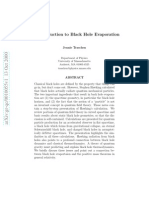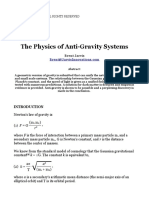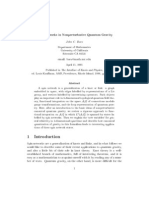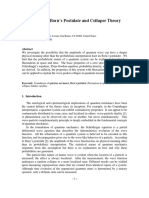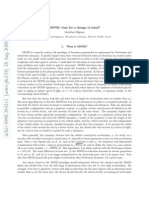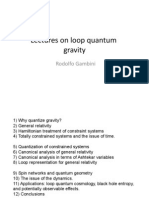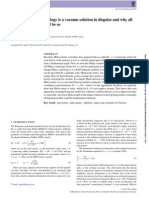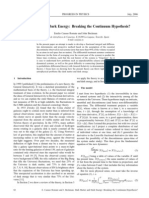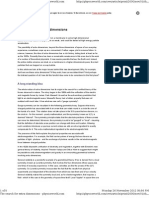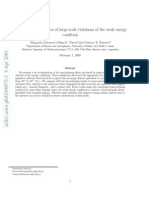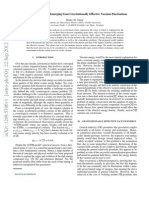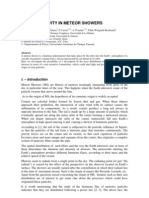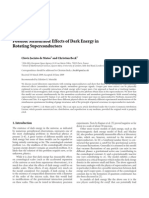Reginald T. Cahill - Black Holes and Quantum Theory: The Fine Structure Constant Connection
Reginald T. Cahill - Black Holes and Quantum Theory: The Fine Structure Constant Connection
Uploaded by
PortsnuyhCopyright:
Available Formats
Reginald T. Cahill - Black Holes and Quantum Theory: The Fine Structure Constant Connection
Reginald T. Cahill - Black Holes and Quantum Theory: The Fine Structure Constant Connection
Uploaded by
PortsnuyhOriginal Title
Copyright
Available Formats
Share this document
Did you find this document useful?
Is this content inappropriate?
Copyright:
Available Formats
Reginald T. Cahill - Black Holes and Quantum Theory: The Fine Structure Constant Connection
Reginald T. Cahill - Black Holes and Quantum Theory: The Fine Structure Constant Connection
Uploaded by
PortsnuyhCopyright:
Available Formats
Volume 4
PROGRESS IN PHYSICS
October, 2006
Black Holes and Quantum Theory: The Fine Structure Constant Connection
Reginald T. Cahill
School of Chemistry, Physics and Earth Sciences, Flinders University, Adelaide 5001, Australia
E-mail: Reg.Cahill@flinders.edu.au
The new dynamical theory of space is further confirmed by showing that the effective black hole masses MBH in 19 spherical star systems, from globular clusters to galaxies, with masses M , satisfy the prediction that MBH = M , where is the 2 fine structure constant. As well the necessary and unique generalisations of the Schr dinger and Dirac equations permit the first derivation of gravity from a deeper o theory, showing that gravity is a quantum effect of quantum matter interacting with the dynamical space. As well the necessary generalisation of Maxwells equations displays the observed light bending effects. Finally it is shown from the generalised Dirac equation where the spacetime mathematical formalism, and the accompanying geodesic prescription for matter trajectories, comes from. The new theory of space is non-local and we see many parallels between this and quantum theory, in addition to the fine structure constant manifesting in both, so supporting the argument that space is a quantum foam system, as implied by the deeper information-theoretic theory known as Process Physics. The spatial dynamics also provides an explanation for the dark matter effect and as well the non-locality of the dynamics provides a mechanism for generating the uniformity of the universe, so explaining the cosmological horizon problem.
1 Introduction Physics has had two distinct approaches to space. Newton asserted that space existed, but was non-dynamical and unobservable. Einstein, in contrast, asserted that space was merely an illusion, a perspective effect in that it is fourdimensional spacetime which is real and dynamical, and that the foliation into space and a geometrical model of time was observer dependent; there was no observer independent space. Hence also according to Einstein space was necessarily unobservable. However both approaches have been challenged by the recent discovery that space had been detected again and again over more than 100 years [111], and that the dynamics of space is now established. The key discovery [2] in 2002 was that the speed of light is anisotropic that it is c only with respect to space itself, and that the solar system has a large speed of some 400 km/s relative to that space, which causes the observed anisotropy. This discovery changes all of physics. The problem had been that from the very beginning the various gas-mode Michelson interferometer experiments to detect this anisotropy had been incorrectly calibrated , and that the small fringe shifts actually seen corresponded to this high speed. As well it has been incorrectly assumed that the success of the Special Relativity formalism requires
least in the limit of zero vorticity. Relativity does not require that the speed of light be isotropic, as is usually incorrectly assumed. Special relativity effects and the presence of gas in the light paths both play critical roles in determining the calibration. In vacuum mode the interferometer is completely insensitive to absolute motion effects, i. e. to the anisotropy of light.
Special At
that the speed of light be isotropic, that an actual 3-space be unobservable. Now that space is known to exist it must presumably also have a dynamics, and this dynamics has been discovered and tested by explaining various phenomena such as (i) gravity, (ii) the dark matter effect, (iii) the bore hole g anomalies, (iv) novel black holes, (v) light bending and gravitational lensing in general, and so on. Because space has been overlooked in physics as a dynamical aspect of reality all of the fundamental equations of physics, such as Maxwells equations, the Schrodinger equation, the Dirac equation and so on, all lacked the notion that the phenomena described by these equations were excitations, of various kinds, of the dynamical space itself. The generalisation of the Schr dinger equation [12] then gave the first derivation o and explanation for gravity: it is a quantum effect in which the wave functions are refracted by the inhomogeneities and time variations of the structured space. However the most striking discovery is that the internal dynamics of space is determined by the fine structure constant [1316]. In this paper we report further observational evidence for this discovery by using a more extensive collection of black hole masses in spherical galaxies and globular clusters . As well we give a more insightful explanation for the dynamics of space. We also show how this quantum-theoretic explanation for gravity leads to a derivation of the spacetime construct where, we emphasise, this is purely a mathematical construct and not an aspect of reality. This is important as it explains why the spacetime dynamics appeared to be successful, at
The generic term black hole is used here to refer to the presence of a compact closed event horizon enclosing a spatial in-flow singularity.
44
R. T. Cahill. Black Holes and Quantum Theory: The Fine Structure Constant Connection
October, 2006
PROGRESS IN PHYSICS
Volume 4
least in those cases where the dark matter effect was not apparent. However in general the metric tensor of this induced spacetime does not satisfy the General Relativity (GR) equations. 2 Dynamics of space At a deeper level an information-theoretic approach to modelling reality (Process Physics [1]) leads to an emergent structured space which is 3-dimensional and dynamic, but where the 3-dimensionality is only approximate, in that if we ignore non-trivial topological aspects of space, then it may be embedded in a 3-dimensional geometrical manifold. Here the space is a real existent discrete but fractal network of relationships or connectivities, but the embedding space is purely a mathematical way of characterising the 3-dimensionality of the network. This is illustrated in Fig. 1. This is not an ether model; that notion involved a duality in that both the ether and the space in which it was embedded were both real. Now the key point is that how we embed the network in the embedding space is very arbitrary: we could equally well rotate the embedding or use an embedding that has the network translating. These general requirements then dictate the minimal dynamics for the actual network, at a phenomenological level. To see this we assume at a coarse grained level that the dynamical patterns within the network may be described by a velocity field v (r, t), where r is the location of a small region in the network according to some arbitrary embedding. For simplicity we assume here that the global topology of the network is not significant for the local dynamics, and so we embed in an E 3 , although a generalisation to an embedding in S 3 is straightforward. The minimal dynamics then follows from the above by writing down the lowest order zero-rank tensors, with dimension 1/t2 , that are invariant under translation and rotation, giving v + (v ) v + t + (tr D)2 + tr (D2 ) = 4G , 8 8 where is the effective matter density, and where Dij = 1 2 vi vj + xj xi . (1)
Fig. 1: This is an iconic graphical representation of how a dynamical network has its inherent approximate 3dimensionality displayed by an embedding in a mathematical space such as an E 3 or an S 3 . This space is not real; it is purely a mathematical artifact. Nevertheless this embeddability helps determine the minimal dynamics for the network, as in (1). At a deeper level the network is a quantum foam system [1]. The dynamical space is not an ether model, as the embedding space does not exist.
that there are only four possible terms, and so we need at most three possible constants to describe the dynamics of space: G, and . G will turn out to be Newtons gravitational constant, and describes the rate of non-conservative flow of space into matter. To determine the values of and we must, at this stage, turn to experimental data. However most experimental data involving the dynamics of space is observed by detecting the so-called gravitational acceleration of matter, although increasingly light bending is giving new information. Now the acceleration a of the dynamical patterns in space is given by the Euler or convective expression a (r, t) lim
t0
v (r + v (r, t) t, t + t) v (r, t) = t v = + (v ) v t
(3)
and this appears in one of the terms in (1). As shown in [12] and discussed later herein the acceleration g of quantum matter is identical to this acceleration, apart from vorticity and relativistic effects, and so the gravitational acceleration of matter is also given by (3). Outside of a spherically symmetric distribution of matter, of total mass M , we find that one solution of (1) is the velocity in-flow field given by v (r) = r 2GM (1 + r
2
(2)
+ ...)
(4)
In Process Physics quantum matter are topological defects in the network, but here it is sufficient to give a simple description in terms of an effective density, but which can also model the dark energy effect and electromagnetic energy effects, which will be discussed elsewhere. We see
Note that then, on dimensional grounds, the spatial dynamics cannot involve the speed of light c, except on the RHS where relativistic effects come into play if the speed of matter relative to the local space becomes large, see [1]. This has significant implications for the nature and speed of so-called gravitational waves.
but only when = , for only then is the acceleration of matter, from (3), induced by this in-flow of the form g(r) = r GM (1 + + . . . ) 2 r2 (5)
which is Newtons Inverse Square Law of 1687, but with an effective mass that is different from the actual mass M .
To see that the flow is inward requires the modelling of the matter by essentially point-like particles.
R. T. Cahill. Black Holes and Quantum Theory: The Fine Structure Constant Connection
45
Volume 4
PROGRESS IN PHYSICS
October, 2006
So Newtons law requires = in (1) although at present a deeper explanation has not been found. But we also see modifications coming from the -dependent terms. A major recent discovery [1316] has been that experimental data from the bore hole g anomaly has revealed that is the fine structure constant, to within experimental errors: = e2/ c 1/137.04. This anomaly is that g does h not decrease as rapidly as predicted by Newtonian gravity or GR as we descend down a bore hole. The dynamics in (1) and (3) gives the anomaly to be g = 2 Gd (6)
where d is the depth and is the density, being that of glacial ice in the case of the Greenland Ice Shelf experiments, or that of rock in the Nevada test site experiment. Clearly (6) permits the value of to be determined from the data, giving = 1/(137.9 5) from the Greenland Ice Shelf data and, independently, =1/(136.8 3) from the Nevada test site data [16]. In general because (1) is a scalar equation it is only applicable for vorticity-free flows v = 0, for then we can write v = u, and then (1) can always be solved to determine the time evolution of u(r, t) given an initial form at some time t0 . The -dependent term in (1) (with now =) and the matter acceleration effect, now also given by (3), permits (1) to be written in the form where g = 4G 4GDM , DM (r, t) (tr D)2 tr(D2 ) , 32G (7) (8)
and in particular that the behaviour of both DM and manifest at a distance irrespective of the dynamics of the intervening space. This non-local behaviour is analogous to that in quantum systems. The non-local dynamics associated with the dynamics has been tested in various situations, as discussed herein, and so its validity is well established. This implies that the minimal spatial dynamics in (1) involves non-local connectivities. We term the dynamics of space in (1) as a flowing space. This term can cause confusion because in normal language a flow implies movement of something relative to a background space; but here there is no existent background space, only the non-existent mathematical embedding space. So here the flow refers to internal relative motion, that one parcel of space has a motion relative to a nearby parcel of space. Hence the absolute velocities in (1) have no observable meaning; that despite appearances it is only the relative velocities that have any dynamical significance. Of course it is this requirement that determined the form of (1), and as implemented via the embedding space technique. However there is an additional role for the embedding space, namely as a coordinate system used by a set of cooperating observers. But again while this is useful for their discourse it is not real; it is not part of reality. 3 Black holes Eqn. (1) has black hole solutions. The generic term black hole is used because they have a compact closed event horizon where the in-flow speed relative to the horizon equals the speed of light, but in other respects they differ from the putative black holes of General Relativity in particular their gravitational acceleration is not inverse square law. The evidence is that it is these new black holes from (1) that have been detected. There are two categories: (i) an in-flow singularity induced by the flow into a matter system, such as, herein, a spherical galaxy or globular cluster. These black holes are termed minimal black holes, as their effective mass is minimal, (ii) primordial naked black holes which then attract matter. These result in spiral galaxies, and the effective mass of the black hole is larger than required merely by the matter induced in-flow. These are therefore termed non-minimal black holes. These explain the rapid formation of structure in the early universe, as the gravitational acceleration is approximately 1/r rather than 1/r2 . This is the feature that also explains the so-called dark matter effect in spiral galaxies. Here we consider only the minimal black holes. Consider the case where we have a spherically symmetric matter distribution at rest, on average with respect to distant space, and that the in-flow is time-independent and radially symmetric. Then (1) is best analysed via (9), which can now
It is probably the case that GR has no such solutions they do not obey the boundary conditions at the singularity, see Crothers [17].
where DM is an effective matter density that would be required to mimic the -dependent spatial self-interaction dynamics. Then (7) is the differential form for Newtons law of gravity but with an additional non-matter effective matter density. It has been shown [1316] that this effect explains the so-called dark matter effect in spiral galaxies. As shown elsewhere it also explains, when used with the generalised Maxwells equations, the gravitational lensing of light by this dark matter effect. An intriguing aspect to the spatial dynamics is that it is non-local. Historically this was first noticed by Newton who called it action-at-a-distance. To see this we can write (1) as an integro-differential equation v = t +G v2 2 d3 r + DM (r , t) + (r , t) (r r ) . | r r |3 (9)
This shows a high degree of non-locality and non-linearity,
Eqn.(1)
also has Hubble expanding space solutions.
46
R. T. Cahill. Black Holes and Quantum Theory: The Fine Structure Constant Connection
October, 2006
PROGRESS IN PHYSICS
Volume 4
Galaxy M87 NGC4649 M84 M32 NGC4697 IC1459 NGC3608 NGC4291 NGC3377 NGC4473 Cygnus A NGC4261 NGC4564 NGC4742 NGC3379 NGC5845 NGC6251 Globular cluster M15 G1
Type E0 E1 E1 E2 E4 E3 E2 E2 E5 E5 E E2 E3 E4 E1 E3 E2
3.4 (1.0, 1.0) 10 2.0 (0.4, 0.6) 109 1.0 (2.0, 0.6) 109 2.5 (0.5, 0.5) 106 1.7 (0.2, 0.1) 108 1.5 (1.0, 1.0) 109 1.9 (1.0, 0.6) 108 3.1 (0.8, 2.3) 108 1.0 (0.9, 0.1) 108 1.1 (0.4, 0.8) 108 2.9 (0.7, 0.7) 109 5.2 (1.0, 1.1) 108 5.6 (0.3, 0.8) 107 1.4 (0.4, 0.5) 107 1.0 (0.6, 0.5) 108 2.4 (0.4, 1.4) 108 6.1 (2.0, 2.1) 108 MBH (+, ) 1.7 (2.7, 1.7) 103 1.8 (1.4, 0.8) 104
MBH (+, )
9
M 6.21.7 10 8.42.2 1011 5.01.4 1011 9.62.6 108 2.00.5 1011 6.61.8 1011 9.92.7 1010 9.52.5 1010 7.82.1 1010 6.91.9 1010 1.61.1 1012 4.51.2 1011 5.41.5 1010 1.10.3 1010 8.52.3 1010 1.90.5 1010 6.71.8 1011 M 4.9 105 1.350.5 107
11
Ref 1 2 3 4 2 5 2 2 2 2 6 7 2 8 9 2 10 Ref 10 11
the in-flow, DM (r) = 2r2
r
s (s) ds + O(2 ) .
(13)
We see that the effective dark matter effect is concentrated near the centre, and we find that the total effective dark matter mass is MDM 4 4 = 2
0 0 2
r2 DM (r) dr = (14)
2
r (r) dr + O( ) = M + O(2 ) . 2
Table 1. Black Hole masses and host masses for various spherical galaxies and globular clusters. References: (1) Macchetto et al. 1997; (2) Gebhardt et al. 2003; (3) average of Bower et al. 1998; Maciejewski & Binney 2001; (4) Verolme et al. 2002; (5) average of Verdoes Klein et al. 2000 and Cappellari et al. 2002; (6) Tadhunter et al. 2003; (7) Ferrarese et al. 1996; (8) Tremaine et al. 2002; (9) Gebhardt et al. 2000; (10) Ferrarese & Ford 1999; (11) Gerssen et al. 2002; (12) Gebhardt et al. 2002. Least squares best fit of this data to Log[MBH ] = Log[ ] + xLog[M ] gives 2 = 1/137.4 and x = 0.974. Data and best fit are shown in Fig. 2. Table adapted from Table 1 of [18].
be written in the form |v (r)|2 = 2 G d3 r DM (r ) + (r ) |r r | (10)
This result applies to any spherically symmetric matter distribution, and is the origin of the terms in (4) and (5). It is thus responsible for the bore hole anomaly expression in (6). This means that the bore hole anomaly is indicative of an in-flow singularity at the centre of the Earth. This contributes some 0.4% of the effective mass of the Earth, as defined by Newtonian gravity. However in star systems this minimal black hole effect is more apparent, and we label MDM as MBH . Table 1 shows the effective black hole masses attributed to various spherically symmetric star systems based upon observations and analysis of the motion of gases and stars in these systems. The prediction of the dynamics of space is that these masses should obey (14). The data from Table 1 is plotted in Fig. 2, and we see the high precision to which (14) is indeed satisfied, and over some 6 orders of magnitude, giving from this data that 1/137.4. The application of the spatial dynamics to spiral galaxies is discussed in [1316] where it is shown that a complete non-matter explanation of the spiral galaxy rotation speed anomaly is given: there is no such stuff as dark matter it is an determined spatial self-interaction effect. Essentially even in the non-relativistic regime the Newtonian theory of gravity, with its universal Inverse Square Law, is deeply flawed. 4 Spacetime The curved spacetime explanation for gravity is widely known. Here an explanation for its putative success is given, for there is a natural definition of a spacetime that arises from (1), but that it is purely a mathematical construction with no ontological status it is a mere mathematical artifact. First consider the generalised Schrodinger [12] i h (r, t) = H(t) (r, t), t 1 2 2 h 2m (15)
in which the angle integrations may be done to yield v (r)2 = 8G r
r 0
s2 DM (s) + (s) ds +
r
(11) s DM (s) + (s) ds ,
+ 8G
where with v = dv (r)/dr, DM (r) = 8G vv v2 + 2 2r r . (12)
To obtain the induced in-flow singularity to O() we substitute the non- term in (11) into (12) giving the effective matter density that mimics the spatial self-interaction of
Previous papers had a typo error in this expression. Thanks to Andree Blotz for noting that.
where the free-fall hamiltonian is H(t) = i v h + v
2
(16)
As discussed in [12] this is uniquely defined by the requirement that the wave function be attached to the dynam47
R. T. Cahill. Black Holes and Quantum Theory: The Fine Structure Constant Connection
Volume 4
PROGRESS IN PHYSICS
October, 2006
which generalises (17) by having a term which limits the speed of the wave packet relative to space to be < c. This equation specifies the trajectory of a spinor wave packet in the dynamical space. We shall now show how this leads to both the spacetime mathematical construct and that the geodesic for matter worldlines in that spacetime is equivalent to trajectories from (19). First we note that (19) may be obtained by extremising the time-dilated elapsed time r0 =
Fig. 2: Log-Log plot of black hole masses MBH and host galaxy or globular cluster masses M (in solar units) from Table 1. Straight line is least squares best fit to Log[MBH ] = Log[ ] + xLog[M ], 2 giving = 1/137.4 and x = 0.974. The borehole g-anomaly gives = 1/(137.95) from the Greenland Ice Shelf data and = 1/(136.83) from the Nevada test site data [16].
v2 dt 1 R c2
1/2
(20)
with respect to the particle trajectory r0 (t) [1]. This happens because of the Fermat least-time effect for waves: only along the minimal time trajectory do the quantum waves remain in phase under small variations of the path. This again emphasises that gravity is a quantum effect. We now introduce a spacetime mathematical construct according to the metric dr v (r, t) dt = g dx dx . (21) ds = dt c2 Then according to this metric the elapsed time in (20) is
2 2 2
ical space, and not to the embedding space, which is a mere mathematical artifact. We can compute the acceleration of a localised wave packet according to g d2 (t), r (t) = dt2 v = + (v ) v + ( t (17) v) vR
dt
dx dx , dt dt
(22)
where vR = v0 v is the velocity of the wave packet relative to the local space, as v0 is the velocity relative to the embedding space. Apart from the vorticity term which causes rotation of the wave packet we see, as promised, that this matter acceleration is equal to that of the space itself, as in (3). This is the first derivation of the phenomenon of gravity from a deeper theory: gravity is a quantum effect namely the refraction of quantum waves by the internal differential motion of the substructure patterns to space itself. Note that the equivalence principle has now been explained, as this gravitational acceleration is independent of the mass m of the quantum system. An analogous generalisation of the Dirac equation is also necessary giving the coupling of the spinor to the actual dynamical space, and again not to the embedding space as has been the case up until now, i h =i c h t +v + 1 2 v + mc2 (18)
and the minimisation of (22) leads to the geodesics of the spacetime, which are thus equivalent to the trajectories from (20), namely (19). Hence by coupling the Dirac spinor dynamics to the space dynamics we derive the geodesic formalism of General Relativity as a quantum effect, but without reference to the Hilbert-Einstein equations for the induced metric. Indeed in general the metric of this induced spacetime will not satisfy these equations as the dynamical space involves the -dependent dynamics, and is missing from GR. So why did GR appear to succeed in a number of key tests where the Schwarzschild metric was used? The answer is provided by identifying the induced spacetime metric corresponding to the in-flow in (4) outside of a spherical matter system, such as the Earth. Then (21) becomes ds2 = dt2 1 dr + c2
2 2GM (1+ + . . . ) 2 dt r 1 2 2 r d2 + sin2 d2 . c
(23)
where and are the usual Dirac matrices. Repeating the analysis in (17) for the space-induced acceleration we obtain g=
2 v vR 1 d vR +(v )v+( v)vR 2 v2 t 1 R 2 dt c 2 c
(19)
This is the Lense-Thirring effect, and such vorticity is being detected by the Gravity Probe B satellite gyroscope experiment [33]. Some details are incomplete in this analysis.
Making the change of variables t t and r r = r with 2 2GM (1+ + . . . ) r 2 t =t + c2 c (24) 4GM (1+ + . . . ) 2GM (1+ + . . . ) 1 2 2 + tanh c3 c2 r
No unique choice of variables is required. This choice simply leads to a well-known form for the metric.
48
R. T. Cahill. Black Holes and Quantum Theory: The Fine Structure Constant Connection
October, 2006
PROGRESS IN PHYSICS
Volume 4
this becomes (and now dropping the prime notation) ds2 = 1 2GM (1+ + . . . ) 2 c2 r c2 dt2 (25)
1 2 r d2 + sin2 d2 c2
dr2 2GM (1+ + . . . ) 2 1 c2 r
We have shown how minimal assumptions about the internal dynamics of space, namely how embeddability in a mathematical space such as an E 3 or an S 3 , expressing its inherent 3-dimensionality, leads to various predictions ranging from the anisotropy of the speed of light, as expressed in the required generalisation of Maxwell s equations, and which has been repeatedly observed since the Michelson-Morley experiment [5] of 1887, to the derivation of the phenomenon of gravity that follows after we generalise the Schr odinger and Dirac equations. This shows that the gravitational acceleration of matter is a quantum effect: it follows from the refraction of quantum waves in the inhomogeneities and timedependencies of the flowing dynamical space. In particular the analysis shows that the acceleration of quantum matter H is identical to the convective acceleration of the structured +v H E = t space itself. This is a non-trivial result. As well in the case E (26) of the Dirac equation we derive the spacetime formalism as +v E H= well as the geodesic description of matter trajectories, but in t doing so reveal that the spacetime is merely a mathematical H = 0, E=0 construct. We note that the relativistic features of the Dirac equation are consistent with the absolute motion of the wave which was first suggested by Hertz in 1890 [34]. As discussfunction in the dynamical 3-space. This emphasis yet again ed elsewhere the speed of EM radiation is now c = 1/ that Special Relativity does not require the isotropy of the with respect to the space, and in general not with respect speed of light, as is often incorrectly assumed. to the observer if the observer is moving through space, as Here we have further extended the observational eviexperiment has indicated again and again. In particular the dence that it is the fine structure constant that determines in-flow in (4) causes a refraction effect of light passing close the strength of the spatial self-interaction in this new physics to the Sun, with the angle of deflection given by by including data from black hole masses in 19 spherical 2 star systems. Elsewhere we have already shown that the 4GM (1 + 2 + . . . ) v (27) new space dynamics explains also the spiral galaxy rotation =2 2 = c2 d c velocity anomaly; that it is not caused by a new form of where v is the in-flow speed at the surface of the Sun, matter, that the notion of dark matter is just a failure of and d is the impact parameter, essentially the radius of the
event horizon of (25) is at a different radius from the actual event horizon of the black hole solutions that arise from (1).
The
which is one form of the the Schwarzschild metric but with the -dynamics induced effective mass shift. Of course this is only valid outside of the spherical matter distribution, as that is the proviso also on (4). As well the above particular change of coordinates also introduces spurious singularities at the event horizon, but other choices do not do this. Hence in the case of the Schwarzschild metric the dynamics missing from both the Newtonian theory of gravity and General Relativity is merely hidden in a mass redefinition, and so didnt affect the various standard tests of GR, or even of Newtonian gravity. Note that as well we see that the Schwarzschild metric is none other than Newtonian gravity in disguise, except for the mass shift. While we have now explained why the GR formalism appeared to work, it is also clear that this formalism hides the manifest dynamics of the dynamical space, and which has also been directly detected in gas-mode interferometer and coaxial-cable experiments. One of the putative key tests of the GR formalism was the gravitational bending of light. This also immediately follows from the new space dynamics once we also generalise the Maxwell equations so that the electric and magnetic fields are excitations of the dynamical space. The dynamics of the electric and magnetic fields must then have the form, in empty space,
Sun. Hence the observed deflection of 8.4 106 radians is actually a measure of the in-flow speed at the Suns surface, and that gives v = 615 km/s. At the Earth distance the Sun induced spatial in-flow speed is 42 km/s, and this has been extracted from the 1925/26 gas-mode interferometer Miller data [1, 3]. These radial in-flows are to be vectorially summed to the galactic flow of some 400 km/s, but since that flow is much more uniform it does not affect the light bending by the Sun in-flow component . Hence the deflection of light by the Sun is a way of directly measuring the in-flow speed at the Suns surface, and has nothing to do with real curved spacetime. These generalised Maxwell equations also predict gravitational lensing produced by the large in-flows associated with new black holes in galaxies. So again this effect permits the direct observation of the these black hole effects with their non-inverse square law accelerations. 5 Conclusions
The vector superposition effect for spatial flows is only approximate, and is discussed in more detail in [35]. The solar system has a galactic velocity of some 42030 km/s in the direction RA=5.2 hr, Dec=67 .
R. T. Cahill. Black Holes and Quantum Theory: The Fine Structure Constant Connection
49
Volume 4
PROGRESS IN PHYSICS
October, 2006
Newtonian gravity and GR. We have also shown that the space dynamics is non-local, a feature that Newton called action-at-a-distance. This is now extended to include the effects of the spatial self-interaction. The numerous confirmations of that dynamics, summarised herein, demonstrate the validity of this non-local physics. Of course since Newton we have become more familiar with non-local effects in the quantum theory. The new space dynamics shows that non-local effects are more general than just subtle effects in the quantum theory, for in the space dynamics this nonlocal dynamics is responsible for the supermassive black holes in galaxies. This non-local dynamics is responsible for two other effects: (i) that the dynamics of space within an event horizon, say enclosing a black hole in-flow singularity affects the space outside of the horizon, even though EM radiation and matter cannot propagate out through the event horizon, as there the in-flow speed exceeds the speed of light. So in this new physics we have the escape of information from within the event horizon, and (ii) that the universe overall is more highly connected than previously thought. This may explain why the universe is more uniform than expected on the basis of interactions limited by the speed of light, i. e. we probably have a solution to the cosmological horizon problem. Elsewhere [1] we have argued that the dynamical space has the form of a quantum foam and so non-local quantum effects are to be expected. So it might be argued that the successful prediction of the masses of these black hole masses, and their dependence on the fine structure constant, is indicative of a grand unification of space and the quantum theory. This unification is not coming from the quantisation of gravity, but rather from a deeper modelling of reality as an information-theoretic system with emergent quantum-space and quantum matter. This work is supported by an Australian Research Council Discovery Grant. References
1. Cahill R. T. Process Physics: From information theory to quantum space and matter. Nova Science, N.Y., 2005. 2. Cahill R. T. and Kitto K. Michelson-Morley experiments revisited. Apeiron, 2003, v. 10(2), 104117. 3. Cahill R. T. Absolute motion and gravitational effects. Apeiron, 2004, v. 11(1), 53111. 4. Cahill R. T. The Michelson and Morley 1887 experiment and the discovery of absolute motion. Progress in Physics, 2005, v. 3, 2529. 5. Michelson A. A. and Morley E. W. Philos. Mag., S. 5, 1887, v. 24, No. 151, 449463. 6. Miller D. C. Rev. Mod. Phys., 1933, v. 5, 203242. 7. Illingworth K. K. Phys. Rev., 1927, v. 3, 692696. 8. Joos G. Ann. der Physik, 1930, Bd 7, 385. 50
9. Jaseja T. S. et al. Phys. Rev., v. A133, 1964, 1221. 10. Torr D. G. and Kolen P. Precision Measurements and Fundamental Constants, ed. by Taylor B. N. and Phillips W. D. Nat. Bur. Stand. (U.S.), Spec. Pub., 1984, v. 617, 675. 11. Cahill R. T. The Roland DeWitte 1991 experiment. Progress in Physics, 2006, v. 3, 6065. 12. Cahill R. T. Dynamical fractal 3-space and the generalised Schr dinger equation: Equivalence Principle and vorticity efo fects. Progress in Physics, 2006, v. 1, 2734. 13. Cahill R. T. Gravity, dark matter and the fine structure constant. Apeiron, 2005, v. 12(2), 144177. 14. Cahill R. T. Dark matter as a quantum foam in-flow effect. In: Trends in Dark Matter Research, ed. J. Val Blain, Nova Science, N.Y., 2005, 96140. 15. Cahill R. T. Black holes in elliptical and spiral galaxies and in globular clusters. Progress in Physics, 2005, v. 3, 5156. 16. Cahill R. T. 3-Space in-flow theory of gravity: Boreholes, blackholes and the fine structure constant. Progress in Physics, 2006, v. 2, 916. 17. Crothers S. J. A brief history of black holes. Progress in Physics, 2006, v. 2, 5457. 18. Marconi A. and Hunt L. K. ApJ, 2003, v. 589, L21L24, part 2. 19. Macchetto F. et al. ApJ, 1997, v. 489, 579. 20. Gebhardt K. et al. ApJ, 2003, v. 583, 92. 21. Bower G. A. et al. ApJ, 2001, v. 550, 75. 22. Maciejewski F. and Binney J. MNRAS, 2001, v. 323, 831. 23. Verolme E. K. et al. MNRAS, 2002, v. 335, 517. 24. Verdoes Klein G. A. et al. AJ, 2000, v. 120, 1221. 25. Cappellari M. et al. ApJ, 2002, v. 578, 787. 26. Tadhunter C. et al. MNRAS, 2003, v. 342, 861. 27. Ferrarese L. et al. ApJ, 1996, v. 470, 444. 28. Tremaine S. et al. ApJ, 2002, v. 574, 740. 29. Gebhardt K. et al. ApJ, 2000, v. 539, L13. 30. Ferrarese L. and Ford H. C. ApJ, 1999, v. 515, 583. 31. Gerssen J. et al. Astron. J., 2002, v. 124, 32703288; Addendum 2003, v. 125, 376. 32. Gebhardt K. et al. ApJ., 2002, v. 578, L41. 33. Cahill R. T. Novel Gravity Probe B frame-dragging effect. Progress in Physics, 2005, v. 3, 3033. 34. Hertz H. On the fundamental equations of electro-magnetics for bodies in motion. Wiedemanns Ann., 1890, v. 41, 369; Electric waves. Collection of scientific papers. Dover Publ., N.Y., 1962. 35. Cahill R. T. The dynamical velocity superposition effect in the quantum-foam in-flow theory of gravity. arXiv: physics/ 0407133.
R. T. Cahill. Black Holes and Quantum Theory: The Fine Structure Constant Connection
You might also like
- Iv. Cooling TowersDocument13 pagesIv. Cooling TowersCharlyn Flores100% (1)
- James Overduin and Hans S. Plendl - Leopold Halpern and The Generalization of General RelativityDocument6 pagesJames Overduin and Hans S. Plendl - Leopold Halpern and The Generalization of General RelativityPortsnuyhNo ratings yet
- Reginald T. Cahill - The Einstein Postulates: 1905-2005: A Critical Review of The EvidenceDocument12 pagesReginald T. Cahill - The Einstein Postulates: 1905-2005: A Critical Review of The EvidencePortsnuyhNo ratings yet
- An Explanation for Expansion of the Universe From Whittaker Potential TheoryDocument4 pagesAn Explanation for Expansion of the Universe From Whittaker Potential TheoryMark TitlemanNo ratings yet
- Mystery of The Cosmological ConstantDocument15 pagesMystery of The Cosmological ConstantMajo BuroNo ratings yet
- Cosmological Models of The UniverseDocument6 pagesCosmological Models of The UniverseAryan GadhaveNo ratings yet
- Traschen J. - An Introduction To Black Hole EvaporationDocument33 pagesTraschen J. - An Introduction To Black Hole EvaporationKhem UpathambhakulNo ratings yet
- Dark EnergyDocument19 pagesDark EnergyEnrique GuardadoNo ratings yet
- Dark EnergyDocument21 pagesDark EnergyPrashant ViratNo ratings yet
- The Matter-Wave Background of Titius-Bode RuleDocument6 pagesThe Matter-Wave Background of Titius-Bode RuleDezso SarkadiNo ratings yet
- Euclid Bams 1183539848Document64 pagesEuclid Bams 1183539848Michael PearsonNo ratings yet
- Aflb 422 M 853Document47 pagesAflb 422 M 853Lane LopesNo ratings yet
- General Relativity and Cosmology: Unsolved Questions and Future DirectionsDocument82 pagesGeneral Relativity and Cosmology: Unsolved Questions and Future DirectionsRuskin PatelNo ratings yet
- Windows On The Universe - PeeblesDocument6 pagesWindows On The Universe - PeeblesluitnoiNo ratings yet
- Universe Investigation Based On Observation of RedDocument6 pagesUniverse Investigation Based On Observation of RedDiivyansh ParekhNo ratings yet
- Pnas00205 0111Document12 pagesPnas00205 0111starmakerNo ratings yet
- The Physics of Anti-Gravity Systems: © 2018 Brent Jarvis All Rights ReservedDocument7 pagesThe Physics of Anti-Gravity Systems: © 2018 Brent Jarvis All Rights Reservedsheraz ahmadNo ratings yet
- 0501051v2Document22 pages0501051v2batuhanerdogan194No ratings yet
- John C. Baez - Spin Networks in Nonperturbative Quantum GravityDocument41 pagesJohn C. Baez - Spin Networks in Nonperturbative Quantum GravityLopmazNo ratings yet
- PlutoDocument10 pagesPlutostephenNo ratings yet
- tmpB89E TMPDocument19 pagestmpB89E TMPFrontiersNo ratings yet
- ElectrogravityDocument76 pagesElectrogravityshahidNo ratings yet
- 0110042v1Document9 pages0110042v1CarlosNo ratings yet
- Qualitative Yang-Mills TheoryDocument34 pagesQualitative Yang-Mills TheoryNomaan AhmedNo ratings yet
- MOND: Time For A Change of Mind?Document12 pagesMOND: Time For A Change of Mind?Neil WuNo ratings yet
- Rodolfo Gambini - Lectures On Loop Quantum GravityDocument92 pagesRodolfo Gambini - Lectures On Loop Quantum GravityArsLexii100% (1)
- Bedingham Et Al. - 2014 - Matter Density and Relativistic Models of Wave Function CollapseDocument9 pagesBedingham Et Al. - 2014 - Matter Density and Relativistic Models of Wave Function CollapseBeto CarreñoNo ratings yet
- The Cosmological Constant Stephen HawkingDocument9 pagesThe Cosmological Constant Stephen HawkingikutmilisNo ratings yet
- Zheng-Cheng Gu and Xiao-Gang Wen - A Lattice Bosonic Model As A Quantum Theory of GravityDocument4 pagesZheng-Cheng Gu and Xiao-Gang Wen - A Lattice Bosonic Model As A Quantum Theory of GravityKiomaxNo ratings yet
- Quantum Field TheoryDocument16 pagesQuantum Field Theoryrr1819100% (1)
- Speed of LightDocument36 pagesSpeed of LightastrologergauravNo ratings yet
- Cosmic Acceleration With Cosmological Soft PhononsDocument5 pagesCosmic Acceleration With Cosmological Soft PhononscrocoaliNo ratings yet
- Quantum PhysicsDocument20 pagesQuantum PhysicsViskersNo ratings yet
- Why All Big Bang Models Correspond To Vacuum Solutions & Why Big Bang Should Be A Mathematical IllusionDocument6 pagesWhy All Big Bang Models Correspond To Vacuum Solutions & Why Big Bang Should Be A Mathematical IllusionDr Abhas MitraNo ratings yet
- Everpresent LambaDocument10 pagesEverpresent LambahypercubicityNo ratings yet
- To What Extent Does String Theory Provide A 'Theory of Everything'?Document4 pagesTo What Extent Does String Theory Provide A 'Theory of Everything'?miaherkanaiduNo ratings yet
- Emilio Casuso Romate and John Beckman - Dark Matter and Dark Energy: Breaking The Continuum Hypothesis?Document5 pagesEmilio Casuso Romate and John Beckman - Dark Matter and Dark Energy: Breaking The Continuum Hypothesis?AzmerzrNo ratings yet
- Gravitacija I Qvantna Mehanika0503003v21Document39 pagesGravitacija I Qvantna Mehanika0503003v21stosicdusanNo ratings yet
- Search For Extra Dimension 1Document5 pagesSearch For Extra Dimension 1Parag Mahajani100% (1)
- Cyclic CosmologyDocument33 pagesCyclic Cosmologyrobespjer69No ratings yet
- 1511 05962 PDFDocument15 pages1511 05962 PDFKleberNevesNo ratings yet
- Think Physics: Beginner's Guide to an Amazingly Wide Range of Fundamental Physics Related QuestionsFrom EverandThink Physics: Beginner's Guide to an Amazingly Wide Range of Fundamental Physics Related QuestionsNo ratings yet
- Margarita Safonova Et Al - Macrolensing Signatures of Large-Scale Violations of The Weak Energy ConditionDocument10 pagesMargarita Safonova Et Al - Macrolensing Signatures of Large-Scale Violations of The Weak Energy ConditionRtpomNo ratings yet
- Cosmology and New Physics: Elementary Particles and Fields TheoryDocument20 pagesCosmology and New Physics: Elementary Particles and Fields TheorysevensixtwoNo ratings yet
- Astrophysics and Space Science 1995Document33 pagesAstrophysics and Space Science 1995vasiliu_paulNo ratings yet
- Standard Model of CosmologyDocument25 pagesStandard Model of Cosmologynayef_ahmadNo ratings yet
- Reginald T. Cahill - Unravelling The Dark Matter - Dark Energy ParadigmDocument53 pagesReginald T. Cahill - Unravelling The Dark Matter - Dark Energy ParadigmPortsnuyhNo ratings yet
- Cosmic Dark Energy Emerging From Gravitationally Effective Vacuum FluctuationsDocument11 pagesCosmic Dark Energy Emerging From Gravitationally Effective Vacuum FluctuationsarmandosanoNo ratings yet
- Scale-Relativity and Quantization of Exoplanet Orbital Semi-Major AxesDocument9 pagesScale-Relativity and Quantization of Exoplanet Orbital Semi-Major AxesmnguyenNo ratings yet
- Heisenberg, "Über Den Anschaulichen Inhalt Der Quantentheoretischen Kinematik Und Mechanik"Document16 pagesHeisenberg, "Über Den Anschaulichen Inhalt Der Quantentheoretischen Kinematik Und Mechanik"Benjamin Crowell50% (2)
- Cosmographic analysis of holographic nonzero torsion frameworkDocument29 pagesCosmographic analysis of holographic nonzero torsion frameworkAitazaz AhsanNo ratings yet
- On The Dimensionality of Space TimeDocument7 pagesOn The Dimensionality of Space TimenikesemperNo ratings yet
- Non Extensivity in Meteor Showers: I. - IntroductionDocument10 pagesNon Extensivity in Meteor Showers: I. - IntroductionCarlitos GuerraNo ratings yet
- Testing Strong-Field Gravity With Tidal Love NumbersDocument25 pagesTesting Strong-Field Gravity With Tidal Love NumbersCroco AliNo ratings yet
- SETI, The Velocity-of-Light Limitation, and The Alcubierre Warp DriveDocument4 pagesSETI, The Velocity-of-Light Limitation, and The Alcubierre Warp DriveTHE NIKOLA TESLA INSTITUTENo ratings yet
- Clovis Jacinto de Matos and Christian Beck - Possible Measurable Effects of Dark Energy in Rotating SuperconductorsDocument10 pagesClovis Jacinto de Matos and Christian Beck - Possible Measurable Effects of Dark Energy in Rotating SuperconductorsOlmnopNo ratings yet
- Lectures On Dark Matter Physics: Mariangela LisantiDocument47 pagesLectures On Dark Matter Physics: Mariangela Lisantiksva2326No ratings yet
- D. S. Krivitsky and V. M. Kontorovich - Quasars in A Merger Model: Comparison With The Observed Luminosity FunctionDocument15 pagesD. S. Krivitsky and V. M. Kontorovich - Quasars in A Merger Model: Comparison With The Observed Luminosity FunctionTuoma2No ratings yet
- LQGDocument64 pagesLQGstephenNo ratings yet
- Dark Matter PaperDocument39 pagesDark Matter PaperCarolina BouvierNo ratings yet
- A Dynamical Theory of the Gravitational Field in a Connected Maxwell and Feynman Spacetime Continuum:On a Unified Field Theory of Space, Time and MatterFrom EverandA Dynamical Theory of the Gravitational Field in a Connected Maxwell and Feynman Spacetime Continuum:On a Unified Field Theory of Space, Time and MatterNo ratings yet
- Ιgnazio Ciufolini- A heritage of John Archibald Wheeler: the accurate measurement of dragging of inertial frames using the LAGEOS satellites and the forthcoming LARES satelliteDocument56 pagesΙgnazio Ciufolini- A heritage of John Archibald Wheeler: the accurate measurement of dragging of inertial frames using the LAGEOS satellites and the forthcoming LARES satellitePortsnuyhNo ratings yet
- M-C. Angoninand Ph. Tourrenc - Cold Atom Interferometer in A Satellite: Orders of Magnitude of The Tidal EffectsDocument19 pagesM-C. Angoninand Ph. Tourrenc - Cold Atom Interferometer in A Satellite: Orders of Magnitude of The Tidal EffectsPortsnuyhNo ratings yet
- Lorenzo Iorio Et Al - On The Possibility of Measuring The Lense-Thirring Effect With A LAGEOS-LAGEOS II-OPTIS MissionDocument13 pagesLorenzo Iorio Et Al - On The Possibility of Measuring The Lense-Thirring Effect With A LAGEOS-LAGEOS II-OPTIS MissionPortsnuyhNo ratings yet
- Ignazio Ciufolini Et Al - Detection of Lense-Thirring E Ect Due To Earth's SpinDocument9 pagesIgnazio Ciufolini Et Al - Detection of Lense-Thirring E Ect Due To Earth's SpinPortsnuyhNo ratings yet
- Herman J. Mosquera Cuesta - Astrophysical Tests For The Novello-De Lorenci-Luciane Theory of GravityDocument14 pagesHerman J. Mosquera Cuesta - Astrophysical Tests For The Novello-De Lorenci-Luciane Theory of GravityPortsnuyhNo ratings yet
- Jaume Gine - On The Origin of The Inertia: The Modified Newtonian Dynamics TheoryDocument18 pagesJaume Gine - On The Origin of The Inertia: The Modified Newtonian Dynamics TheoryPortsnuyhNo ratings yet
- Sergey Siparov - Anisotropic Metric For The Gravitation Theory: New Ways To Interpret The Classical GRT TestsDocument13 pagesSergey Siparov - Anisotropic Metric For The Gravitation Theory: New Ways To Interpret The Classical GRT TestsPortsnuyhNo ratings yet
- Reginald T. Cahill - Lunar Laser-Ranging Detection of Light-Speed Anisotropy and Gravitational WavesDocument5 pagesReginald T. Cahill - Lunar Laser-Ranging Detection of Light-Speed Anisotropy and Gravitational WavesPortsnuyhNo ratings yet
- Martin Tajmar and Clovis de Matos - Gravitomagnetic Fields in Rotating Superconductors To Solve Tate's Cooper Pair Mass AnomalyDocument6 pagesMartin Tajmar and Clovis de Matos - Gravitomagnetic Fields in Rotating Superconductors To Solve Tate's Cooper Pair Mass AnomalyOlmnopNo ratings yet
- Horst Eckardt and Douglas W. Lindstrom - Solution of The ECE Vacuum EquationsDocument17 pagesHorst Eckardt and Douglas W. Lindstrom - Solution of The ECE Vacuum EquationsPortsnuyhNo ratings yet
- Progress in Physics 2007: Volume 3Document108 pagesProgress in Physics 2007: Volume 3PortsnuyhNo ratings yet
- Reginald T. Cahill - Unravelling The Dark Matter - Dark Energy ParadigmDocument53 pagesReginald T. Cahill - Unravelling The Dark Matter - Dark Energy ParadigmPortsnuyhNo ratings yet
- Cahill FinalPaper) PDFDocument25 pagesCahill FinalPaper) PDFLindy KhoNo ratings yet
- FX X XX X X: AP Calculus BC:: Quiz One:: Shubleka NameDocument1 pageFX X XX X X: AP Calculus BC:: Quiz One:: Shubleka NameteachopensourceNo ratings yet
- Astm D 3542Document4 pagesAstm D 3542manoj madurangaNo ratings yet
- Anti-Dandruff Shampoo With Zinc Pyrithione: INCI Name, Trade Name Weight % FunctionDocument2 pagesAnti-Dandruff Shampoo With Zinc Pyrithione: INCI Name, Trade Name Weight % FunctionandreeaNo ratings yet
- WRN3 K 2 Ur Rhs 654 ZF Eoe NDocument86 pagesWRN3 K 2 Ur Rhs 654 ZF Eoe NMayank BaghelNo ratings yet
- Isolation and Purification of Isoaloeresin D and Aloin From Aloe Vera by High-Speed Counter-Current ChromatographyDocument5 pagesIsolation and Purification of Isoaloeresin D and Aloin From Aloe Vera by High-Speed Counter-Current ChromatographyvixmarNo ratings yet
- Correlations (1976 77)Document5 pagesCorrelations (1976 77)mmm2025No ratings yet
- Lecture 1 - Introduction To CEMDocument31 pagesLecture 1 - Introduction To CEMZhenhua HuangNo ratings yet
- ANSYS Workbench 3D Fluid AnalysisDocument5 pagesANSYS Workbench 3D Fluid AnalysisREKing1911No ratings yet
- Department of Science and Humanities: Erode Sengunthar Engineering College Thudupathi-57Document7 pagesDepartment of Science and Humanities: Erode Sengunthar Engineering College Thudupathi-57rkumaravelanNo ratings yet
- Chemistry Lab Report: Rate of Reaction: Sekolah CiputraDocument11 pagesChemistry Lab Report: Rate of Reaction: Sekolah CiputraMercy JunfandiNo ratings yet
- Latex Sealants: Standard Specification ForDocument3 pagesLatex Sealants: Standard Specification ForKelly-Moore Việt NamNo ratings yet
- Helix AntennaDocument18 pagesHelix AntennaNina ButtNo ratings yet
- Skid Structure Calculation Rev.a - MBD - APPROVEDDocument45 pagesSkid Structure Calculation Rev.a - MBD - APPROVEDnamasral100% (6)
- Multi-Component Distillation: Prof. S. Scott, Che 128, Uc Santa BarbaraDocument23 pagesMulti-Component Distillation: Prof. S. Scott, Che 128, Uc Santa Barbarasch203100% (1)
- Numerical Solution of Fluid Flow: Nguyen Quang KhaiDocument7 pagesNumerical Solution of Fluid Flow: Nguyen Quang KhaiKhai NguyenNo ratings yet
- Riverbank Protection With Gabion Structure: Gabion MattressDocument61 pagesRiverbank Protection With Gabion Structure: Gabion MattressNishant SarrafNo ratings yet
- Towers and SignalsDocument23 pagesTowers and SignalsWassan IdreesNo ratings yet
- Output Feedback Controllers For Systems With Structured UncertaintyDocument5 pagesOutput Feedback Controllers For Systems With Structured UncertaintyBikshan GhoshNo ratings yet
- 이휘소 논문 PDFDocument4 pages이휘소 논문 PDFjemin12798No ratings yet
- GE Lighting Systems Decaflood PLO II & RLO II Series Spec Sheet 9-80Document4 pagesGE Lighting Systems Decaflood PLO II & RLO II Series Spec Sheet 9-80Alan MastersNo ratings yet
- Fluid MechanicsDocument8 pagesFluid MechanicsFearless HeroNo ratings yet
- Laboratory Exercise No. 6 Determination of Specific Gravity of Soil Using Volumetric FlaskDocument1 pageLaboratory Exercise No. 6 Determination of Specific Gravity of Soil Using Volumetric FlaskEinstein JeboneNo ratings yet
- Wave+simulation MatlabDocument16 pagesWave+simulation MatlabEsmael AdemNo ratings yet
- Liquid Holdup in PackedDocument11 pagesLiquid Holdup in PackedVictor VazquezNo ratings yet
- Tecnotion TBW Series SpecsheetDocument2 pagesTecnotion TBW Series SpecsheetElectromateNo ratings yet
- Ta Di Misura PDFDocument44 pagesTa Di Misura PDFCristian BandilaNo ratings yet
- Fluxus F/G60X Series: Precise, Flexible and VersatileDocument6 pagesFluxus F/G60X Series: Precise, Flexible and VersatileHafiz AminNo ratings yet
- Various Issues in Computer Aided Analysis and Design of Building Structures Presentation by SPCE, MumbaiDocument49 pagesVarious Issues in Computer Aided Analysis and Design of Building Structures Presentation by SPCE, MumbaiAHSANNo ratings yet






